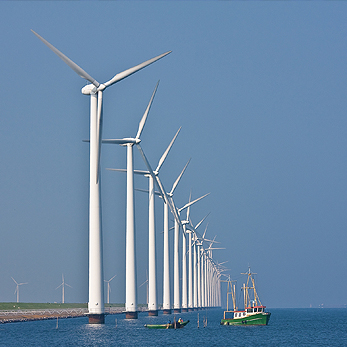Over the past ten years, energy production by offshore wind farms has emerged as a new use of coastal and shallower offshore waters Figure 9.7. Operation and proposed development of offshore wind farms is currently limited to Regions II and III. In 2009, 17 wind farms with a total of 713 turbines were either operational or under construction covering an area of over 500 km2. These will have a combined capacity of almost 1900 MW. Around 800 turbines are expected to be operational by 2010. The development of large-scale offshore wind farms is being driven by demands for increased renewable energy production as a result of policies to reduce reliance on fossil fuels and to mitigate the effects of climate change. The EU is committed to having 20% of its energy production from renewable sources by 2020. By the end of 2009 a further 50 wind farms (2490 turbines) had been authorised, but construction work for most was still to start. Applications had been submitted for another 74 (2463 turbines).
Impacts arise throughout the life cycle of wind farms, including: site selection, construction, operation, decommissioning and removal. Impacts include the effects of noise on marine mammals and fish, disturbance and loss of habitats, bird collisions and visual intrusion. Wind farms can also interfere with other uses of the sea – causing hazards to shipping and the servicing of the offshore industry, and displacing fishing activities and recreational boating. There may also be conflict with marine conservation objectives.
Knowledge of the wider effects of offshore wind farms on environmental quality is limited and mainly based on data from monitoring at specific sites, similar activities, government sponsored research and development, and predictions from EIAs. Monitoring of bird abundance in the vicinity of the Horns Rev and Nysted offshore wind farms off Denmark shows a statistically significant decrease in numbers of some seabird species up to 2 km from the wind farms. Such displacement could potentially give rise to a loss of feeding grounds. Marine mammals have been disturbed by noise from pile driving up to 20 km from the Horns Rev wind farm. As with other construction on the seabed, wind farms may also have positive impacts, for example, by restricting other human activities, such as fishing. The degree and extent of these benefits is still being established.
Currently, the location, size and separation of the relatively few operational offshore wind farms in the OSPAR area are such that population-scale impacts on marine organisms have not been found. However, many proposed wind farms are more extensive than those in operation and in some cases several hundred turbines are planned per farm. The potential for cumulative and transboundary effects (particularly on migratory species) will increase as more wind farms are developed.
OSPAR has developed guidance on environmental considerations for the development of offshore wind farms. This recommends best practices to assess, minimise and manage the potential impacts of wind farms. All OSPAR countries have national approval procedures for marine developments; Germany, the Netherlands and the UK have specific guidance for offshore wind farms. OSPAR has a database on operational and proposed sites and promotes the exchange of information through its website.
Many of the environmental impacts associated with offshore wind farms can be mitigated through national licensing procedures. These should ensure that the OSPAR guidance is followed, in particular, that sites are selected to avoid important seabird feeding areas, construction is timed to minimise effects on spawning fish, and routes taken by construction vessels are positioned to minimise disturbance to seabirds. Monitoring at operational wind farms will provide the basis for better management at future wind farms.
With the expected increase in the number and scale of offshore wind farms beyond 2010, OSPAR will need to address the gaps in knowledge about the effects of wind farms on the marine ecosystem. Information from monitoring of operational wind farms should be exchanged and assessed. Impacts from wind farms need to be kept at acceptable levels in relation to reference populations of species that are affected. These could be populations that are functionally or regionally significant or populations within biogeographic regions or flyways. Where appropriate, consideration of cumulative and transboundary effects should become a more critical part of the national assessment and consenting process. OSPAR will need to keep under review the need for measures or guidance to address these aspects. In the interim, existing approaches to wind farm management should be followed to ensure that impacts are minimised. These approaches should be supported by measures to mitigate effects such as underwater noise (e.g. from pile driving during construction), electromagnetic fields, bird displacement and physical changes to the seabed.


